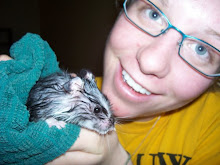
- Pour 1/4 inch of water in crock pot (to keep the lard on the bottom from burning before the rest melts), set on low (but not "warm")
- Add defrosted lump of ground leaf lard, chop into smaller and smaller chunks as it warms to help with even melting. I guess you need to chop the lard if it's not ground, which my next batch isn't so I'll try out.
- Keep the lid off so the water cooks off, and wait two hours, stirring and de-clumping occasionally
- Pour into colander lined with cheese cloth and sift out chunks (aka crackle)
- Pour beautiful golden liquid into jars
- Do NOT eat the crackle! Ignore directions which tell you it's delicious and tastes like bacon bits. It tastes like pig ear wax, and will make you gag unless you have four legs and a long, furry tail (maybe I cooked it incorrectly? maybe my palete is too americanized?)
On a side note - leaf lard (aka "kidney lard") is the more desirable type of lard which comes from in amongst the internal organs rather than beneath the skin (aka "fatback"). Wish the fat in the below picture was easier to see! It is beautiful, glistening pure white when it is pulled off the carcass (the back fat is more opaque and yellowish). There's a third kind of lard called the "caul fat" which is a lacy membrane that surrounds the GI tract and is really gorgeous! Apparently it's not good for rendering, but can be used to wrap meat or (I just read) as a "covering for pate." Not sure why you'd want your pate covered in a lacy layer of fat, but I've also never had pate so I'm clearly out of the loop. I have a few bags in the freezer, but i'm not planning on any wrapped meats or covered pates, so maybe I'll just drape cecil's evening meal in fancy fat now and then. It's all about the presentation with these dignified felines afterall.


1 comment:
i love spain in iowa and flagged that same post for when i do have pigs to render lard from! great post!
Post a Comment